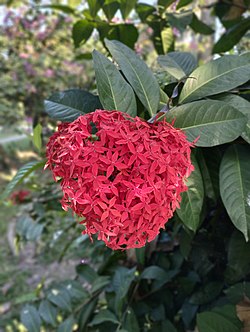| Ixora | |
|---|---|
 | |
| Chinese ixora | |
| Scientific classification | |
| Kingdom: | Plantae |
| Clade: | Tracheophytes |
| Clade: | Angiosperms |
| Clade: | Eudicots |
| Clade: | Asterids |
| Order: | Gentianales |
| Family: | Rubiaceae |
| Subfamily: | Ixoroideae |
| Tribe: | Ixoreae |
| Genus: | Ixora L. |
| Type species | |
| Ixora coccinea | |
| Species | |
About 544, see List of Ixora species | |
| Synonyms [1] | |
Ixora is a genus of flowering plants in the family Rubiaceae. [1] It is the only genus in the tribe Ixoreae. It consists of tropical evergreen trees and shrubs and holds around 544 species. [2] Though native to the tropical and subtropical areas throughout the world, its centre of diversity is in Tropical Asia. Ixora also grows commonly in subtropical climates in the United States, such as Florida where it is commonly known as West Indian jasmine.



















